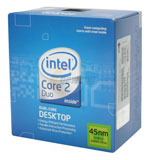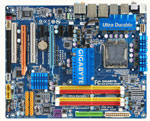Intel Value Midrange
Intel owns the very top in CPU performance with their Core i7, but the Phenom II has made AMD competitive through the upper midrange. That means that midrange is an area where you can now choose Intel or AMD based on the unique features of each platform or expansion capabilities, rather than one brand dominating performance. Since Phenom II is built on a 45nm process, even overclocking capabilities are now competitive with Intel with Phenom II.
The Intel value midrange system builds around a fast Intel Core 2 Duo CPU. For most applications and gaming a faster dual-core CPU is normally a better performance choice that a slower quad-core. CPU intensive applications like video manipulation do benefit from a quad-core CPU, which should be your choice if those applications are important to you. A few recent games are finally taking advantage of quad-core as well, but those are the exception rather than the rule.
| Intel Value Midrange PC | ||
| Hardware | Component | Price |
| Processor | Intel Core 2 Duo E8400 Wolfdale 65W 45nm (3.0GHzx2, 6MB L2) | $165 |
| Cooling | Intel Retail HSF | - |
| Video | PowerColor AX4850 Radeon HD 4850 512MB (after $10 Rebate) | $120 |
| Motherboard | Gigabyte GA-EP45-UD3P (after $20 Rebate) | $115 |
| Memory | 4GB (2x2GB) DDR2-1066 Corsair Twin2X4096-8500C5 5-5-5-15 (after $20 rebate) | $39 |
| Hard Drive | Seagate Barracuda 7200.11 ST31000333AS 1TB | $90 |
| Optical Drive | LG BD/HD DVD / 16x DVD+/- RW GGC-H20LK | $99 |
| Audio | On-Board | - |
| Case | Antec Three Hundred ATX Mid Tower | $55 |
| Power Supply | BFG Tech LS Series LS-550 550W SLI/CrossFire 80 PLUS Certified | $80 |
| Base System Total | $763 | |
| Display | Acer X233Hbid 23" 5ms HDMI Full HD 1080P LCD Monitor (1920x1080) | $190 |
| Speakers | Logitech X-540 70W 5.1 Speakers - Retail | $79 |
| Input | Microsoft CA9-00001 Black PS/2 Standard Keyboard and Optical USB/PS2 Mouse - OEM | $16 |
| Operating System | Microsoft Vista Home Premium OEM | $99 |
| Complete System Bottom Line | $1147 | |
 |
The CPU choice is one of the fastest Core 2 Duo chips with 6MB of L2 cache on the market. The E8400 at 3.00GHz is just two steps below the fastest Core 2 E8600, which clocks at 3.33GHz. It also overclocks exceptionally well, reaching 4GHz and even higher with relative ease. Because of this OC ability, and the value goal of this system build, The E8400 has been matched with components that are also excellent choices for overclocking. The E8400 is plenty fast on its own, but if overclocking interests you this Intel setup will be ready for action - and ready to overclock to wherever your particular E8400 can go.
 |
The big brother to the UD3R selected in our under $800 guide is the $135 Gigabyte GA-EP45-UD3P that has a similar feature set but adds a second x16 slot (in place of a PCI slot) for dual x8 CrossFire operation. You can currently save a few bucks with a $20 mail-in rebate. The board provides an excellent overclocking platform along with great stability. If the second x16 slot is not important to you, we suggest sticking with the UD3R. This P45 chipset motherboard has earned its reputation as a sterling overclocker, while also maintaining excellent stability. It is a good match to the selected Core 2 Duo E8400 or an alternate quad-core Q8200 (2.33GHz 2x3MB L2).
The stock Intel cooler is adequate for modestly overclocking a Core 2 Duo. Better cooling is needed to push the CPU to its capabilities, or if your CPU choice is an Intel quad-core you plan to overclock. The Xigmatek HDT-D1283 120mm Rifle Cooler did very well in our cooling tests and it is a good match to the E8500. OCZ also markets a similar 120 Rifle cooler and either should work well in this system.
For this value midrange system, faster memory with more overclocking head-room was chosen. With the current Corsair rebates some of their best memory is available at truly bargain prices. The choice for the Intel system is a Corsair 4GB DDR2-1066 (PC2-8500) kit. The Corsair Twin X kit specifies fast 5-5-5 timings at DDR2-1066, which is an impressive spec even if you never overclock. Value is good at the normal $59, but with the current $20 rebate the price is a very easy-on-the-budget $39.










73 Comments
View All Comments
RadnorHarkonnen - Wednesday, April 8, 2009 - link
Don't be Pedantic. Chill Out mates.I have a X2 4800+ OCed to 3Ghz. I game on it, i have a small file server on it, an exchange server always rolling, I GIMP some fotos, use sum torrentz, test like things i have fun with on my VMware, the wife is always seeing a movie of some sort (Desperate housewives or sex in the city, or some crap like that) plugged via HDMI to my TV. And much more...
A bit of this, a bit of that.
I personally like his rig. I wouldn't buy one like his, but hey there are other priorities. Maybe in the summer ill buy another for crossfire.
Wineohe - Tuesday, April 7, 2009 - link
Hmm. Not sure I get 1TB Barracuda. Sometimes price isn't everything. I guess you gotta spread the love.Wesley Fink - Wednesday, April 8, 2009 - link
The Seagate is now quite reliable and fast. The speed is a true 7200rpm, and not a "green" 5200rpm. Cache is 32MB, and not 16MB like many competing drives.Warranty is reduced to 3 years from the previous 5 years, but warranty service and replacement is very easy directly with Seagate. Seagate still offers the Enterprise version of this drive with 5-year warranty for $140, but if truth be know it is the same drive with a longer warranty and a higher price to pay for the longer coverage.
You can pay more for the same features and specifications. As we have said many times, you are generally safe with an HD from the major players and you can shop on price as long as specs are the same. There are good WD choices as well.
MadMan007 - Wednesday, April 8, 2009 - link
Seriously? Did you just say it's a great drive based upon paper specs? Features and specifications do not equal real world performance. Seagate drives after the 7200.10s should not be recommended. Supposed reliability issue aside the firmware is heavily slanted toward reads and the drives perform middle of the pack overall when looking at a wide range of real world uses. I understand for an article like this there's a need to stick to a strict price point but anyone who wants a 7200RPM 1TB drive ought to look elsewhere (WD drives are great atm) or if they don't need the space they'd be better served by a 7200RPM 640GB WD drive.Wesley Fink - Wednesday, April 8, 2009 - link
We use both the recent Seagate and WD 1TB drives. Both have performed well in the labs.MadMan007 - Wednesday, April 8, 2009 - link
Then you aren't testing them well enough but that's ok I've never read Anandtech for HD reviews. Heck the last non-SSD review is almost a year old and that was the V-Raptor, before that there is a 1TB drive review which is thoroughly outdated. Obviously in fairlyland everyone has only SSDs by now, the SSD articles are intriguing but don't reflect what people actually buy for storage as your own guides show.MadMan007 - Wednesday, April 8, 2009 - link
Sorry the above reads more rantishly than I meant it. Anyway my point was that quoting a bunch of paper specs doesn't mean much.erple2 - Friday, April 10, 2009 - link
Some thing that seems to get lost a lot is the question for the normal user:"How much faster is this drive in the stuff I care about?"
Benchmarks are good, I suppose, but they're also ridiculously non-linear. a two fold increase in sequential read performance in HD Tach doesn't translate into a two fold reduction in windows boot up time (or application startup time).
Maybe they are linear, but only with extenuating circumstances - If I have an old drive that loads application X in 20 seconds, getting a more recent drive could reduce the load time by 2 seconds. Getting a drive that's "twice" as fast as the slower new drive may reduce the application loading time by twice the increase, not half the time - the app now loads in 16 seconds rather than 18 seconds.
I dunno. It seems that the more I look at "real world" scenarios (which I understand are very hard to quantify and benchmark - they're essentially wall clock timings), the difference between 2 drives of the same rotational speed are marginal. Heck, even the difference between a 7200RPM drive and a 10k drive seems awfully marginal.
How often do I copy a single huge (on the order of 1 gigabyte) file that's stored sequentially? I dunno. Most of my data is lots of files that are smaller than 10 MiB (music and pictures), with significant numbers that are in the < 1 MiB range (everything else that isn't MP3's or pictures).
Huh.. Now I sound like I'm ranting.
However, if Anandtech is using the drives all the time in their test systems (and they haven't failed), then I'd believe that they're at least reliable. They may not be faster than a couple of Raptors in Raid 0, but from what else I've read, that's a total waste of time and money for my usage patterns (which don't include running a heavily used database, or other server application).
marc1000 - Tuesday, April 7, 2009 - link
wow, while I read the article I lost the 1st comment spot.. hehewell, I read a lot of these guides here at AT, and should shay the components choices are generally good. too bad I live in a country other than USA or England, so I can never buy those parts with the "real" pricing, instead I always pay higher for newer parts... it's a joke for us.......
anyway, I would like to say to anyone interested that these new CPUs and GPUs are really terrific performers. Today I have a fairly simple Core2Duo e7200 (2.6ghz 3mb cache) paired with a Radeon HD3850 and 4GB RAM. I never could completely stress this simple system... even gaming, I can run almost all games at a very good quality (22" LCD monitor with 16x10res), except for CRYSIS of course (but I don't like it anyway).
ssj4Gogeta - Wednesday, April 8, 2009 - link
"too bad I live in a country other than USA or England, so I can never buy those parts with the "real" pricing, instead I always pay higher for newer parts"same here. :( Especially when a new graphics card is launched. The price is as high as 2x the price in the US.